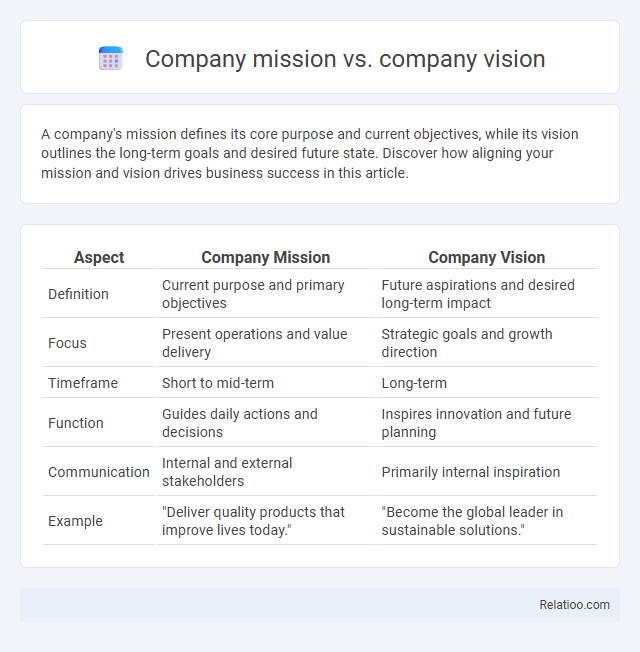A company's mission defines its core purpose and current objectives, while its vision outlines the long-term goals and desired future state. Discover how aligning your mission and vision drives business success in this article.
Table of Comparison
| Aspect | Company Mission | Company Vision |
|---|---|---|
| Definition | Current purpose and primary objectives | Future aspirations and desired long-term impact |
| Focus | Present operations and value delivery | Strategic goals and growth direction |
| Timeframe | Short to mid-term | Long-term |
| Function | Guides daily actions and decisions | Inspires innovation and future planning |
| Communication | Internal and external stakeholders | Primarily internal inspiration |
| Example | "Deliver quality products that improve lives today." | "Become the global leader in sustainable solutions." |
Introduction to Company Mission and Vision
Company mission defines your organization's core purpose and primary objectives, serving as a practical guide for daily operations and strategic decisions. Company vision represents a future-oriented aspiration, illustrating what your business strives to achieve in the long term. Clear differentiation between mission and vision helps align your team's efforts and drives coherent growth strategies.
Defining Company Mission
Defining your company mission involves clearly articulating the core purpose and fundamental goals of your organization, guiding daily operations and decision-making. A mission statement focuses on what your company does, whom it serves, and how it provides value, differentiating it from the broader, future-oriented company vision. While the company vision outlines long-term aspirations and the guidance offers principles or strategies, the mission serves as the actionable foundation driving your business forward.
Defining Company Vision
Company vision defines a long-term aspirational goal that guides organizational growth and strategic direction, serving as a foundational blueprint for decision-making. Unlike the company mission, which focuses on present purpose and operational objectives, the vision articulates where the company aims to be in the future, inspiring stakeholders and aligning efforts. Clear vision statements enhance organizational commitment, facilitate goal-setting, and support sustained innovation and competitive advantage.
Key Differences Between Mission and Vision
Company mission defines the organization's current purpose, detailing what it does, who it serves, and how it operates to achieve specific goals. Company vision outlines the future aspirations, providing a clear image of where the company aims to be in the long term. Guidance encompasses the principles and values that steer decision-making, aligning both mission and vision with strategic actions.
Importance of a Clear Mission Statement
A clear mission statement defines a company's core purpose and values, directing strategic decisions and uniting employees under a common goal. Differentiating from the company vision, which outlines long-term aspirations, the mission provides immediate focus and guides daily operations. Effective guidance stems from a strong mission, ensuring consistent messaging and fostering stakeholder trust.
Importance of an Inspiring Vision Statement
A company vision statement articulates the long-term aspirations and inspires employees by providing a clear, motivating direction for the future, differentiating it from a company mission, which focuses on current purpose and operations. An inspiring vision statement is crucial for aligning organizational goals, enhancing employee engagement, and driving innovation by creating a shared sense of purpose. Effective guidance integrates both mission and vision, ensuring strategic decisions reflect the company's core values and future ambitions.
How Mission and Vision Shape Company Strategy
Company mission defines your organization's core purpose and values, guiding daily operations and decision-making processes. Vision articulates the long-term aspirations and desired future state, influencing strategic planning and innovation direction. Together, mission and vision shape company strategy by aligning goals, motivating employees, and establishing a clear framework for growth and competitive advantage.
Real-World Examples of Mission vs Vision
Company mission defines Your organization's core purpose and immediate goals, exemplified by Tesla's mission to accelerate the world's transition to sustainable energy. Company vision portrays the long-term aspirations and desired future state, such as Google's vision to organize the world's information and make it universally accessible. Guidance provides the strategic framework and values that align mission and vision, ensuring consistent decision-making and growth.
Common Mistakes in Crafting Mission and Vision
Confusing company mission with company vision often leads to vague or overly broad statements, where missions are mistaken for future aspirations instead of present purpose. A common mistake in crafting mission statements is neglecting to define the company's core values and operational focus, while vision errors frequently arise from lacking a clear, inspirational long-term goal that motivates stakeholders. Properly distinguishing mission as the organization's current role, vision as its future aim, and guidance as actionable principles ensures strategic clarity and alignment.
Tips for Aligning Mission and Vision Statements
To align company mission and vision statements effectively, focus on clarity and consistency by ensuring the mission defines the present purpose while the vision articulates the future aspirations. Incorporate stakeholder input and core values to create a cohesive narrative that guides decision-making and strategy. Regularly review and update both statements to reflect evolving business goals and market dynamics, maintaining relevance and motivation.

Infographic: Company Mission vs Company Vision
 relatioo.com
relatioo.com